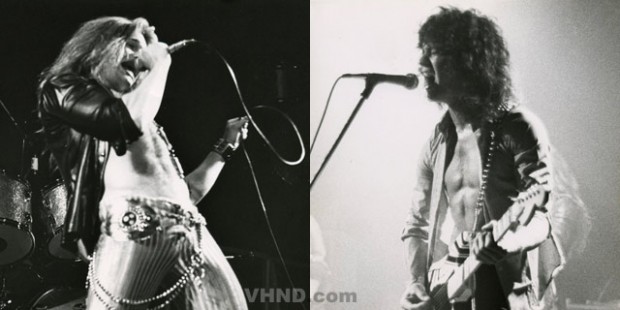David Lee Roth pays tribute to Eddie Van Halen during the last Van Halen concert (10/4/2015 at The Hollywood Bowl)
Author Greg Renoff has been sharing his thoughts on the passing of Eddie Van Halen to many media outlets over the past week, including the Van Halen News Desk. Most recently he penned an in-depth article devoted to the legendary fire and ice chemistry between Eddie and frontman David Lee Roth.
In a piece published by The Los Angeles Times titled “An unlikely Pasadena love story: The high-school bromance of Eddie Van Halen and David Lee Roth” Renoff takes Van Halen fans back to where the journey began:
Early in the summer of 1973, singer David Lee Roth and guitarist Eddie Van Halen performed together for the first time. Playing in front of an audience of buzzed students from John Muir, Blair and Pasadena high schools in an east Pasadena backyard, this embryonic version of Van Halen, then called Mammoth, blasted out songs by Black Sabbath, Grand Funk Railroad and Cream, rattling windows and shattering eardrums while party attendees chugged keg beer.
Last week, Eddie Van Halen died from cancer, at age 65, and tributes to his transformational musical contributions poured in from around the world. But long before anyone outside of the San Gabriel Valley had heard of the band, this pairing of two aspiring musicians who had little in common save their long hair drew together a generation of hard-rock-loving SoCal teens.

While the Van Halen brothers would remain enrolled in their neighborhood high school, David Lee Roth, who’d moved to greater Pasadena from Massachusetts in 1963, would have a different experience. Roth, the Jewish son of a successful ophthalmologist, would be bused from the city’s south side to Muir in 1969, his sophomore year. Even Roth, who had grown up around Black people and had a longstanding affinity for Black culture, likely felt unprepared for the cultural immersion that awaited him at Muir. His high school friend George Perez explains, “At Muir, you had militant Blacks, who had Afros and Angela Davis posters in their lockers. You had longhaired white hippies and Mexicans as well.”
Roth was adept at navigating this racial and ethnic terrain. Vincent Carberry, who was tight with Roth, explains that Roth “got very good at bridging the gaps” and “getting along with everyone, whether that meant embracing Black and Spanish music, playing soccer or whatever else.”
Another friend, Dan Hernandez, concurs, saying that while Roth’s volubility made him a great diplomat, ultimately Roth had credibility in the halls of Muir because “he was basically a white dude who wanted to be Black. He had soul.”By the time Roth graduated [from John Muir High School] in 1972, he’d begun singing in a rock band. His showmanship and charisma drew a strong multi-ethnic following among Muir students. He’d also begun sizing up the competition, namely Mammoth, a trio consisting of the Van Halen brothers and bassist Mark Stone, at a number of backyard parties. Recognizing the immense musical talents of Eddie and Alex, he began angling for a way to join their band as lead vocalist.
At first, the Van Halen brothers were less than enthusiastic about Roth’s entreaties. Everything, from Roth’s social class and cultural style to his musical taste, turned them off. Roth’s father had money. The young singer wore flares and suspenders, a Bowie-inspired shag, and platforms. He liked Billy Preston, Sly and the Family Stone and the Rolling Stones. The Van Halen brothers were blue-collar kids who wore their hair straight and long. Chain-smoking Camels, they pioneered the grunge look long before the birth of Nirvana: They favored Pendleton flannels, lightweight cords or faded denims, and desert boots.
Most important, they had little use for the soul and funk music favored by Roth. Instead, Mammoth played the hard rock hits of the day by Black Sabbath, Deep Purple and Cream. As Roth told the Guardian in 2012, Van Halen and their Pasadena High buddies were “98% Jeff Spicoli.” Apart from their deep mutual interest in becoming professional rock musicians, they had little in common.
Ultimately, Roth won the brothers over, in no small part because Eddie, who was Mammoth’s lead vocalist and guitarist, didn’t like singing lead. Roth, however, saw more sociological factors at work, telling The Times in 2012 that the “immigrant energy” of the Van Halen family, along with his own intense drive to succeed, made them a perfect pairing: “desperate people seeking desperate fortune — with a smile.” Soon after, upon Roth’s suggestion, the band changed its name from Mammoth to Van Halen.
Although it took the Van Halen brothers’ fans some time to warm up to Roth, Van Halen inarguably became a better band with a ringmaster like Roth fronting the group. This union of talents also broadened and expanded the band’s fan base by drawing together a broad swath of fans from their respective high schools. “Backyard parties,” Roth observed in his 1997 autobiography, “developed into an art form.” From 1973-75, Van Halen would play dozens and dozens of these gatherings.
You can read the complete L.A. Times article by Renoff HERE.
Renoff also took some time to talk with Rolling Stone‘s Brian Hiatt shortly after the news broke of Eddie’s death. You can hear that interview courtesy of the Rolling Stone Music Now podcast below. The episode also includes an interview Hiatt conducted with Eddie back in 2008:
UPDATE (10/17/20): Renoff has just shared a great Eddie story as told to him by long-time Van Halen producer Ted Templeman via his Facebook page.
Greg Renoff is a historian and the author of “Van Halen Rising: How a
Southern California Backyard Party Band Saved Heavy Metal” and “Ted
Templeman: A Platinum Producer’s Life in Music.”
Main photo images courtesy of K. Todd Storch/Flickr.